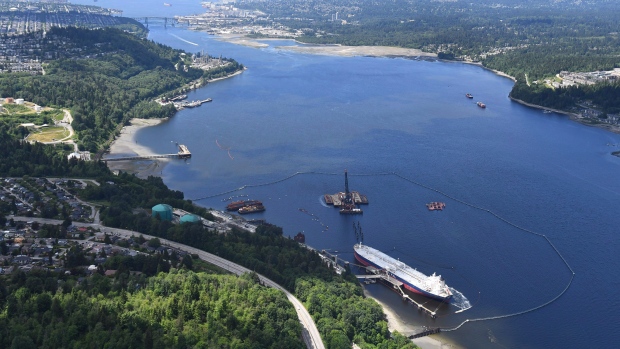
OTTAWA – The federal government is widely expected to green light the Trans Mountain expansion project a second time today but, even with a Yes vote, construction is likely weeks, if not months away.
The federal cabinet will be reconsidering the project at its weekly meeting this morning, nine months after the Federal Court of Appeal shelved the original approval. Any decision isn’t likely to be announced until after the markets close for the day.
International Trade Minister Jim Carr said Monday, the pipeline decision is “very significant.”
“It’s all about moving our resources to export markets but doing it in a responsible and sustainable way in consultation with Indigenous communities and with an eye on environmental stewardship,” he said. “Those are the pillars we have been talking about and that we will honour and continue to honour.”
Construction halted after the court decision last summer.
Trans Mountain Canada, the federal Crown corporation now running the pipeline and which will oversee the expansion, said in a statement Monday that an updated construction schedule for the project won’t happen unless the government approves the project. Construction also won’t restart immediately.
“There are regulatory and commercial steps that need to be completed before we can get shovels in the ground, including re-mobilizing the contractors, distributing required notifications and ensuring we’ve met all our pre-construction conditions,” the statement said.
The government approved the expansion in 2016 but after the court decision last summer, Natural Resources Minister Amarjeet Sohi ordered the National Energy Board to look at the impacts more oil tankers will have on marine life and hired former Supreme Court justice Frank Iacobucci to oversee a new round of consultations with 117 affected Indigenous communities.
The court cited a failure on both those fronts as the reasons for overturning the original cabinet approval.
Sohi said Monday the government has been moving ever since the court decision last August, and blamed the former Conservative government for the delay.
“One of the reasons that project was stalled is that when the process of review was started in 2013 under Stephen Harper’s government, Conservatives failed to include the impact of marine shipping on the marine environment,” said Sohi.
“We are changing that. We are engaging with Indigenous communities in the right way to move forward on the project.”
The project was mostly reviewed during the tenure of the former government. After the Liberals came to power in 2016, they extended the review period for the pipeline to undertake additional Indigenous consultations and asked the NEB to also look at the impact the pipeline would have on greenhouse gas emissions. It was still not enough to satisfy the court.
If cabinet approves the expansion again, it may impose some additional conditions on the pipeline to address the concerns of Indigenous communities, including possibly changing the route in some places. The NEB added 16 more conditions in February when it recommended approval after considering the impacts of marine shipping.
Ottawa is under intense pressure from the energy sector and the Alberta government to approve the pipeline. They argue existing pipelines are at capacity and the oil sands need more ways to get product to market. There is also pressure on the government because Ottawa bought the existing pipeline almost a year ago for $4.5 billion, when Kinder Morgan Canada investors got cold feet.
The company didn’t want to proceed after multiple court challenges from environment groups, Indigenous communities and in 2018, the newly elected NDP government in British Columbia. So Ottawa stepped in to buy the pipeline and planned to expand it and then sell it back to the private sector.
The court decision upended that plan.
The existing pipeline was built more than 60 years ago and runs 1,150-km between Edmonton and Burnaby, B.C. The expansion, first proposed seven years ago by Kinder Morgan Canada, seeks to build a second pipeline roughly parallel to the first. Eleven per cent of the route for the expansion requires new rights of way to be established.
Conservative House leader Candice Bergen is skeptical even with government approval that construction will get underway on the expansion.
“Over the last four years, though, the Prime Minister has done everything in his power to destroy jobs in Canada’s energy sectors,” Bergen said.
New Democrat MP Peter Julian said Monday he was expecting a “rubber stamp approval” of the project. The NDP, Green Party leader Elizabeth May, and major Canadian environment lobby groups, argue that the Liberals can’t approve the project if they have any real intention of meeting Canada’s climate change commitments.
Environment Minister Catherine McKenna says the government not only intends to meet existing commitments on emissions but to exceed them in line with the requirements that the United Nations Intergovernmental Panel on Climate Change says are needed to keep the planet from getting too hot.
The National Energy Board in 2016 said the production of another 590,000 barrels of oil to hit the capacity of the twinned pipeline could generate 14-17 million more tonnes of greenhouse gases each year. However the board warned that production may happen with or without the pipeline.
Canada’s current commitment under the Paris climate change accord is to cut emissions to 513 million tonnes annually. In 2017, the most recent year the measurement is available, emissions were 716 million tonnes. The Alberta oil sands accounted for about 70 million tonnes of that.
To meet the United Nations’ suggested targets, Canada would have to get to closer to 385 million tonnes.